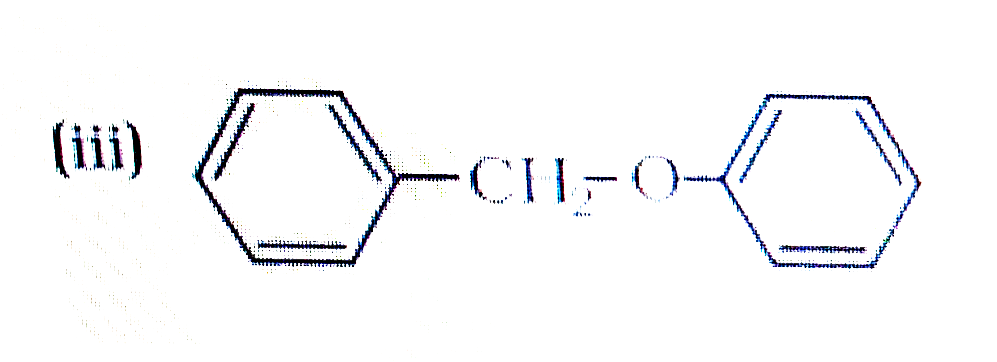Draw the diagram showing micelle formation by the following detergent.
CH3(CH2)10CH2Os¯¯¯¯¯O3Na
To illustrate the micelle formation of the detergent sodium lauryl sulfate (CH₃(CH₂)₁₀CH₂OSO₃Na), we will follow these steps:
Step 1: Understand the Structure of Sodium Lauryl Sulfate
- Sodium lauryl sulfate consists of a long hydrophobic alkyl chain (the hydrocarbon part) and a hydrophilic sulfate group (the ionic part).
- The alkyl chain is represented as CH₃(CH₂)₁₀CH₂, and the sulfate group is represented as OSO₃Na.
Step 2: Identify the Hydrophobic and Hydrophilic Parts
- The hydrophobic part (tail) is the long alkyl chain, which repels water.
- The hydrophilic part (head) is the sulfate group, which interacts with water.
Step 3: Draw the Micelle Structure
1. Draw the Alkyl Chain: Start by drawing a long zigzag line to represent the alkyl chain (the hydrophobic tail).
2. Add the Sulfate Group: At one end of the alkyl chain, draw a small circle or a group to represent the sulfate group (the hydrophilic head).
3. Arrange the Molecules: In the micelle formation, the hydrophobic tails will point inward, away from the water, while the hydrophilic heads will point outward, towards the water.
4. Complete the Micelle: Draw several of these structures clustered together, showing the tails pointing inward and the heads pointing outward.
Final Diagram
- The final diagram should show a spherical structure where the tails are clustered in the center and the heads are facing the surrounding water.
- Sodium lauryl sulfate consists of a long hydrophobic alkyl chain (the hydrocarbon part) and a hydrophilic sulfate group (the ionic part).
- The alkyl chain is represented as CH₃(CH₂)₁₀CH₂, and the sulfate group is represented as OSO₃Na.
- The hydrophobic part (tail) is the long alkyl chain, which repels water.
- The hydrophilic part (head) is the sulfate group, which interacts with water.
1. Draw the Alkyl Chain: Start by drawing a long zigzag line to represent the alkyl chain (the hydrophobic tail).
2. Add the Sulfate Group: At one end of the alkyl chain, draw a small circle or a group to represent the sulfate group (the hydrophilic head).
3. Arrange the Molecules: In the micelle formation, the hydrophobic tails will point inward, away from the water, while the hydrophilic heads will point outward, towards the water.
4. Complete the Micelle: Draw several of these structures clustered together, showing the tails pointing inward and the heads pointing outward.
- The final diagram should show a spherical structure where the tails are clustered in the center and the heads are facing the surrounding water.
Topper's Solved these Questions
- CHEMISTRY IN EVERYDAY LIFEBOOK - NCERT EXEMPLAR ENGLISHCHAPTER - CHEMISTRY IN EVERYDAY LIFEEXERCISE - Match the Column
6 Videos
- CHEMISTRY IN EVERYDAY LIFEBOOK - NCERT EXEMPLAR ENGLISHCHAPTER - CHEMISTRY IN EVERYDAY LIFEEXERCISE - Assertion and Reason
14 Videos
- CHEMISTRY IN EVERYDAY LIFEBOOK - NCERT EXEMPLAR ENGLISHCHAPTER - CHEMISTRY IN EVERYDAY LIFEEXERCISE - Long Answer Type Qns
4 Videos
- CHEMICAL KINETICSBOOK - NCERT EXEMPLAR ENGLISHCHAPTER - CHEMICAL KINETICSEXERCISE - LONG ANSWER TYPE QUESTIONS
5 Videos
- COORDINATION COMPOUNDSBOOK - NCERT EXEMPLAR ENGLISHCHAPTER - COORDINATION COMPOUNDSEXERCISE - Long Answer Type Question
5 Videos
Similar Questions
Knowledge Check
The type of isomerism shown by the following compounds is
CH3CH2CH2CH2CH3,CH3−CH3∣CH−CH2CH3,CH3−CH3∣C∣CH3−CH3Aposition isomerismBmetamerismCring-chain isomerismDchain isomerism
Draw the Lewis structure of the following compounds:
CH3CH2CH3
View SolutionName the functional groups present in the following compounds.
(a) CH3COCH2CH2CH2CH3 , (b) CH3CH2CH2COOH
(c ) CH3CH2CH2CH2CHO , (d) CH3CH2OH
View SolutionGive the major products that are formed by heating each of the following ethers with HI.
(i) CH3−CH2−CH3| CH−CH2−O−CH2−CH3
(ii) CH3−CH2−CH2−O−CH3∣C∣CH3−CH2−CH3
(iii)
View SolutionGive IUPAC name for each of the following
CH2=CHCH2CH2C∣∣O(CH3)
View SolutionShow the polarisation of carbon-magnesium bond in the following structure.
CH3−CH2−CH2−CH2−Mg−X
View SolutionDistinguish between the following :
(i) CH3−CO−CH2CH3 and CH3−CH2−CH2−CHO
View SolutionGive IUPAC name for each of the following
CH3CH2−O−CH−CH3 | CH3
View Solution
